Abstract
An efficient one-pot synthesis of 1,6-diamino-2-oxo-1,2,3,4-tetrahydro- pyridine-3,5-dicarbonitrile derivatives by four-component piperidine-catalyzed reactions of a ketone, malononitrile, ethyl cyanoacetate and hydrazine hydrate under ultrasound irradiation is described. This method provides several advantages such as shorter reaction times, excellent yields, and a simple workup procedure.
1. Introduction
Multi-component reactions (MCRs) have been designed to produce elaborate biologically active compounds and have become an important area of research in organic, combinatorial, and medicinal chemistry [1,2,3,4]. MCRs offer a wide range of possibilities for the efficient construction of highly complex molecules in a single procedure, thus avoiding the complicated purification operations and allowing savings of both solvents and reagents, making them perfectly amenable to automation for combinatorial synthesis. In the past decade there have been tremendous developments in MCRs and great efforts continue to be made to develop new MCRs [5,6,7,8,9].
Nitrogen-containing heterocyclic compounds are widespread in natural products and medicinal agents [10], and their applications in biologically active pharmaceuticals, agrochemicals, and functional materials are becoming more and more important [11,12]. Among them, pyridinone derivatives have been received considerable attention as a result of their biological activities and as an interesting template for medicinal chemistry [13,14,15,16]. The conventional method for the synthesis of pyridinones is ammonization of pyranone at a high temperature or in a sealed tube [17,18]. Recently, a number of improved methods have been reported in the literatures for the synthesis of this heterocyclic system [19,20,21]. However, most of these methodologies suffer from disadvantages such as multi-step procedures, long reaction times, unsatisfactory yields, and the use of organic solvents or toxic reagents. These facts prompted us towards further investigation in search for a more efficient methods for the preparation of this kind of compounds.
Ultrasound irradiation has been increasingly used in organic synthesis in recent years. A large number of organic reactions can be carried out in a higher yield, shorter reaction time and under milder reaction conditions under ultrasonication. Compared with traditional methods, this method is more convenient and can be easily controlled [22]. Nevertheless, the use of ultrasound in heterocyclic systems has not been fully explored [23,24]. As a consequence of our interest in the synthesis of heterocyclic compounds under ultrasound irradiation [25,26,27,28,29,30], we report herein for the first time a facile one-pot synthesis of pyridin-2(1H)-one derivatives via four-component reactions of a ketone, malononitrile, ethyl cyanoacetate and hydrazine catalyzed by piperidine under ultrasound irradiation.
2. Results and Discussion
Initially, the four-component reaction of acetone (1a), malononitrile (2), ethyl cyanoacetate (3) and hydrazine hydrate (4) as a simple model was investigated to establish the feasibility of the strategy and to optimize the reaction conditions (Scheme 1). The effects of solvents and catalysts were evaluated for this model reaction, and the results are summarized in Table 1. It was found that when the reaction was carried out without any catalysts only traces of product were detected, even after 10 h under ultrasound irradiation (Table 1, entry 1). To improve the yields, we examined this reaction using different bases (Table 1, entries 2–6). Based on the reaction times and the yields, piperidine was identified as the optimal catalyst with 5a being isolated in 93% yield (Table 1, entry 2). In order to further improve the product yields, we tried to perform the reaction in higher temperatures under ultrasound irradiation, but the yield did not increase (Table 1, entries 7–8). Subsequently, we turned to testing the effect of solvents. MeOH, CH3CN, THF, and water showed no superiority to EtOH (Table 1, entries 9–12). Therefore, EtOH is the solvent of choice for this reaction. To optimize the catalyst loading, 5, 10, 15, 20 and 25 mol% of piperidine was tested, respectively (Table 1, entries 13, 2, 14–16). A 10 mol% loading of piperidine was sufficient to push the reaction forward and 5 mol% of piperidine was not enough. Higher amounts of piperidine did not lead to a significant changes in the reaction yields.

Scheme 1.
The model reaction.

Table 1.
Optimization of reaction conditions a.
| Entry | Solvent | Temperature (°C) | Catalyst | Time (min) | Isolated Yield (%) |
|---|---|---|---|---|---|
| 1 | EtOH | rt | No catalyst | 600 | trace |
| 2 | EtOH | rt | Piperidine (10%) | 30 | 93 |
| 3 | EtOH | rt | NaOH (10%) | 240 | 80 |
| 4 | EtOH | rt | KOH (10%) | 180 | 78 |
| 5 | EtOH | rt | Na2CO3 (10%) | 360 | 62 |
| 6 | EtOH | rt | EtONa (10%) | 240 | 83 |
| 7 | EtOH | 40 | Piperidine (10%) | 30 | 89 |
| 8 | EtOH | 50 | Piperidine (10%) | 30 | 85 |
| 9 | MeOH | rt | Piperidine (10%) | 40 | 85 |
| 10 | CH3CN | rt | Piperidine (10%) | 120 | 65 |
| 11 | THF | rt | Piperidine (10%) | 90 | 79 |
| 12 | Water | rt | Piperidine (10%) | 120 | trace |
| 13 | EtOH | rt | Piperidine (5%) | 60 | 86 |
| 14 | EtOH | rt | Piperidine (15%) | 60 | 90 |
| 15 | EtOH | rt | Piperidine (20%) | 30 | 91 |
| 16 | EtOH | rt | Piperidine (25%) | 30 | 89 |
a Reaction conditions: acetone (1 nmol), malononitrile (1 nmol), ethyl cyanoacetate (1 nmol), hydrazine hydrate (1 nmol) and piperidine (0.1 nmol) in solvent (10 mL) under ultrasonic waves and the ultrasonic power 250 W, irradiation frequency 40 kHz.
Using the optimal conditions, we investigated the substrate scope of the transformation (Scheme 2). The results are summarized in Table 2. As shown in Table 2, aliphatic chain ketones and cyclic ketones were well tolerated under the reaction conditions, leading to the final products in satisfactory yields. However, when the aromatic ketones (such as acetophenone, 4-bromoacetophenone, and 4-methylacetophenone) and aromatic aldehyde (such as benzaldehyde) were used, only traces of products were detected.

Scheme 2.
The synthesis of pyridin-2(1H)-one derivatives 5.

Table 2.
Synthesis of pyridin-2(1H)-one derivatives 5.
| Entry | Ketone | Product | With US | Without US | ||
|---|---|---|---|---|---|---|
| Time (min) | Yield (%) | Time (min) | Yield (%) | |||
| 1 |  |  | 30 | 94 | 120 | 72 |
| 2 |  |  | 30 | 92 | 120 | 69 |
| 3 |  |  | 30 | 93 | 180 | 70 |
| 4 |  |  | 30 | 92 | 180 | 60 |
| 5 |  |  | 35 | 92 | 180 | 65 |
| 6 |  | 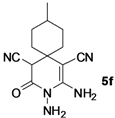 | 40 | 91 | 180 | 67 |
| 7 |  | 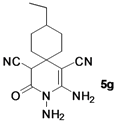 | 40 | 90 | 180 | 62 |
| 8 |  | 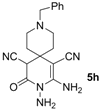 | 40 | 91 | 240 | 59 |
| 9 |  | 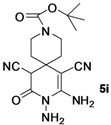 | 40 | 89 | 300 | 60 |
| 10 |  |  | 35 | 88 | 300 | 60 |
| 11 |  |  | 35 | 89 | 180 | 64 |
The structures of 5 were characterized using IR, 1H-NMR, and 13C-NMR spectroscopies, and HRMS analysis. Compound 5a exhibited characteristic IR stretching frequencies in the 3415, 3346, 3305, 2175, 1702, and 1632 cm−1 regions for NH2, CN, C=O, and C=C, respectively. In the 1H-NMR spectrum of compound 5a the amino group protons show two singlets at δ 6.61 and 5.15. The methyl group protons show two singlets at δ 1.20 and 1.04 due to the two methyl groups. A singlet appearing at δ 4.50 was assigned to the C-3 proton of the pyridine ring. In addition, HRMS analyses were consistent with the structures. The structure of 5a was further confirmed by X-ray diffraction. The molecular structure of 5a is shown in Figure 1.
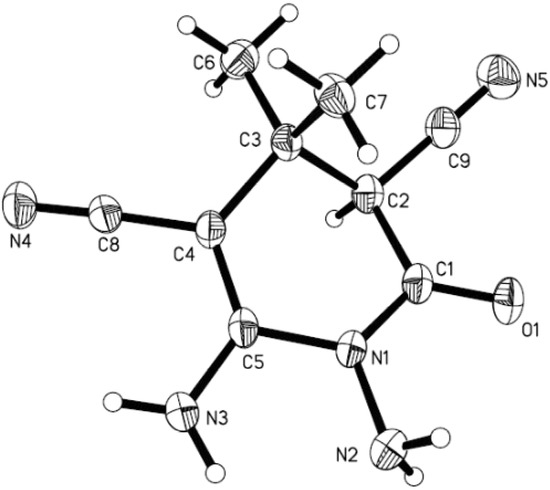
Figure 1.
The crystal structure of compound 5a.
In this tetrahydropyridine ring, because of the existence of conjugation, the distance C4–N4 [1.338(3) Å] is significantly shorter than the typical Csp2–N bond distance (1.426 Å) [31]. The tetrahydropyridine ring adopts a distorted boat conformation, atoms C3, N1, C4 and C5 are coplanar, while C1 and C2 deviate from the plane by 0.4358(39) and −0.3639(38) Å, respectively.
Although the detailed mechanism of this reaction has not yet been clarified, the formation of compounds 5 can be explained by the possible mechanism presented in Scheme 3. First, a Knoevenagel condensation of ketone 1 with malononitrile 2 is proposed to give the intermediate A. A condensation of ethyl cyanoacetate 3 with hydrazine hydrate 4 is also proposed to give the intermediate B. Michael addition of intermediate B to A catalyzed by piperidine should then occur to provide intermediate C, which undergoes intramolecular cyclization to give intermediate D. In the last step, the intermediate D is tautomerized to afford the product 5.

Scheme 3.
The proposed mechanism for the synthesis of compound 5.
3. Experimental
3.1. General Information
Melting points are uncorrected. IR spectra were recorded on Varian F-1000 spectrometer in KBr with absorptions in cm−1. All 1H-NMR data were determined on a Varian Inova-400 MHz but the 13C-NMR spectra had been run on the Varian Inova-300 MHz instrument, J values are in Hz. Chemical shifts are expressed in ppm downfield from internal standard TMS. HRMS analyses were carried out using a Bruker microTOF-Q instrument. X-ray diffraction was recorded on a Smart-1000 CCD diffractometer. Ultrasonication was performed in a KQ-250E medical ultrasound cleaner with a frequency of 40 kHz and an output power of 250 W. The reaction flask was located at the maximum energy area in the cleaner, and the surface of the reactions was placed slightly lower than the level of the water. Observation of the surface of the reaction solution during vertical adjustment of vessel depth will show the optimum position by the point at which maximum surface disturbance occurs. The reaction temperature was controlled by addition or removal of water from the ultrasonic bath.
3.2. General Procedure for the Synthesis of 1,6-Diamino-2-oxo-1,2,3,4-Tetrahydro-Pyridine-3,5-Dicarbonitrile Derivatives 5
A 100 mL flask was charged with ketone 1 (1 mmol), malononitrile 2 (1 mmol), ethyl cyanoacetate 3 (1 mmol), hydrazine hydrate 4 (1 mmol) and piperidine (10 mol%, 0.1 mmol) in ethanol (10 mL). The mixture was sonicated in the water bath of an ultrasonic cleaner at 25–30 °C. After the completion of the reaction (monitored by TLC), the reaction mixture was concentrated in vacuo to remove the solvent. The residue was quenched with water and then filtered. The crude products were purified by recrystallization from ethanol to afford the pure products 5.
1,6-Diamino-4,4-dimethyl-2-oxo-1,2,3,4-tetrahydropyridine-3,5-dicarbonitrile (5a). White solid, 147.7 mg, 72% yield; m.p.: 198–200 °C. IR (KBr, cm−1): 3415, 3346, 3305, 2175, 1702, 1632, 1569, 1428, 1340, 1218, 917, 858; 1H-NMR (400 MHz, DMSO-d6,): δ (ppm) 1.04 (s, 3H, CH3), 1.20 (s, 3H, CH3), 4.50 (s, 1H, CH), 5.15 (s, 2H, NH2), 6.61 (s, 2H, NH2). 13C-NMR (75 MHz, DMSO-d6): δ (ppm) 24.6, 27.0, 33.0, 47.9, 62.4, 115.8, 119.8, 153.8, 162.8; HRMS: calculated for C9H10N5O [M−H]+: 204.0885, found 204.0867.
1,6-Diamino-4-methyl-2-oxo-4-propyl-1,2,3,4-tetrahydropyridine-3,5-dicarbonitrile (5b). Black solid, 160.9 mg, 69% yield; m.p.: 136–138 °C. IR (KBr, cm−1): 3426, 3318, 2999, 2187, 1709, 1641, 1582, 1418, 1326, 1200, 942, 878, 785; 1H-NMR (400 MHz, DMSO-d6): δ (ppm) 0.85–0.86 (m, 3H, CH3), 1.10–1.27 (m, 7H, 2 × CH2,CH3), 4.65 (s, 1H, CH), 5.21 (s, 2H, NH2), 6.66 (s, 2H, NH2); 13C-NMR (75 MHz, DMSO-d6): δ (ppm) 13.7, 16.4, 23.9, 34.7, 43.9, 47.0, 59.1, 114.7, 119.5, 152.9, 162.0; HRMS: calculated for C11H14N5O [M−H]+: 232.1198, found 232.1186.
1,6-Diamino-4,4-diethyl-2-oxo-1,2,3,4-tetrahydropyridine-3,5-dicarbonitrile (5c). White solid, 163.3 mg, 70% yield; m.p.: 170–172 °C. IR (KBr, cm−1): 3445, 3317, 2988, 2195, 1707, 1645, 1576, 1418, 1369, 1206, 989, 886, 736; 1H-NMR (400 MHz, DMSO-d6): δ (ppm) 0.83 (t, J = 7.2 Hz, 3H, CH3), 0.91 (t, J = 7.2 Hz, 3H, CH3), 1.33–1.39 (m, 2H, CH2), 1.48–1.55 (m, 1H, CH), 1.78–1.82 (m, 1H, CH), 4.19 (s, 1H, CH), 5.20 (s, 2H, NH2), 6.72 (s, 2H, NH2); 13C-NMR (75 MHz, DMSO-d6): δ (ppm) 8.4, 8.9, 28.6, 30.8, 40.0, 43.7, 57.4, 115.4, 120.5, 155.0, 163.3; HRMS: calculated for C11H14N5O [M−H]+: 232.1198, found 232.1186.
1,6-Diamino-4-cyclopropyl-4-methyl-2-oxo-1,2,3,4-tetrahydropyridine-3,5-dicarbonitrile (5d). Gray solid, 138.6 mg, 60% yield; m.p.: 181–182 °C. IR (KBr, cm−1): 3624, 3446, 2880, 2189, 1713, 1637, 1565, 1431, 1284, 1224, 1166, 940, 839, 691; 1H-NMR (400 MHz, DMSO-d6): δ (ppm) −0.04–0.02 (m, 1H, CH), 0.10–0.16 (m, 1H, CH), 0.31–0.40 (m, 2H, CH2), 0.84–0.91 (m, 1H, CH), 1.32 (s, 3H, CH3), 4.72 (s, 1H, CH), 5.23 (s, 2H, NH2), 6.72 (s, 2H, NH2); 13C-NMR (75 MHz, DMSO-d6): δ (ppm) −0.7, 0.6, 16.1, 24.8, 34.8, 47.2, 54.9, 114.8, 119.6, 153.9, 161.9; HRMS: calculated for C11H12N5O [M−H]+: 230.1042, found 230.1039.
2,3-Diamino-4-oxo-3-azaspiro[5.5]undec-1-ene-1,5-dicarbonitrile (5e). White solid, 159.4 mg, 65% yield; m.p.: 156–158 °C. IR (KBr, cm−1): 3499, 3296, 2899, 2169, 1699, 1632, 1561, 1400, 1376, 1258, 914, 864, 681; 1H-NMR (400 MHz, DMSO-d6): δ (ppm) 1.04–1.07 (m, 1H, CH), 1.20–1.36 (m, 1H, CH), 1.45–1.70 (m, 8H, 4 × CH2), 4.52 (s, 1H, CH), 5.26 (s, 2H, NH2), 6.71 (s, 2H, NH2); 13C-NMR (75 MHz, DMSO-d6): δ (ppm) 21.4, 21.6, 25.3, 33.4, 34.2, 35.4, 45.8, 60.8, 115.9, 121.0, 154.8, 162.4; HRMS: calculated for C12H14N5O [M−H]+: 244.1198, found 244.1172.
2,3-Diamino-9-methyl-4-oxo-3-azaspiro[5.5]undec-1-ene-1,5-dicarbonitrile (5f). White solid, 173.6 mg, 67% yield; m.p.: 175–176 °C. IR (KBr, cm−1): 3426, 3318, 2164, 1709, 1626, 1538, 1410, 1299, 1148, 902, 836, 687; 1H-NMR (400 MHz, DMSO-d6): δ (ppm) 0.89 (d, J = 6.4 Hz, 3H, CH3), 1.14–1.22 (m, 1H, CH), 1.26–1.41 (m, 2H, CH2), 1.45–1.61 (m, 4H, 2 × CH2), 1.64–1.77 (m, 2H, CH2), 4.49 (s, 1H, CH), 5.23 (s, 2H, NH2), 6.68 (s, 2H, NH2); 13C-NMR (75 MHz, DMSO-d6): δ (ppm) 22.5, 30.4, 30.5, 31.6, 32.8, 34.1, 34.9, 48.8, 59.4, 115.8, 121.7, 155.2, 163.0; HRMS: calculated for C13H16N5O [M−H]+: 258.1335, found 258.1336.
2,3-Diamino-9-ethyl-4-oxo-3-azaspiro[5.5]undec-1-ene-1,5-dicarbonitrile (5g). White solid, 169.5 mg, 62% yield; m.p.: 184–186 °C. IR (KBr, cm−1): 3418, 3216, 2186, 1712, 1656, 1566, 1432, 1240, 1121, 956, 812, 662; 1H-NMR (400 MHz, DMSO-d6): δ (ppm) 0.86 (t, J = 6.4 Hz, 3H, CH3), 1.10–1.25 (m, 4H, 2 × CH2), 1.37 (t, J = 8.0 Hz, 1H, CH), 1.50–1.70 (m, 5H, 2 × CH2, CH), 1.77 (d, J = 9.6 Hz, 1H, CH), 4.50 (s, 1H, CH), 5.24 (s, 2H, NH2), 6.68 (s, 2H, NH2); 13C-NMR (75 MHz, DMSO-d6): δ (ppm) 11.7, 28.1, 29.4, 32.8, 34.1, 35.3, 38.2, 48.8, 59.4, 107.9, 115.8, 121.7, 155.2, 163.0; HRMS: calculated for C14H18N5O [M−H]+: 272.1511, found 272.1484.
2,3-Diamino-9-benzyl-4-oxo-3,9-diazaspiro[5.5]undec-1-ene-1,5-dicarbonitrile (5h). Yellow solid, 198.5 mg, 59% yield; m.p.: 114–116 °C. IR (KBr, cm−1): 3602, 3425, 3330, 2932, 2174, 1715, 1625, 1561, 1427, 1345, 1229, 1078, 985, 795, 740; 1H-NMR (400 MHz, DMSO-d6): δ (ppm) 1.68 (s, 4H, 2 × CH2), 2.28–2.60 (m, 4H, 2 × CH2), 3.48 (s, 2H, NCH2), 4.57 (s, 1H, CH), 5.25 (s, 2H, NH2), 6.78 (s, 2H, NH2), 7.25–7.35 (m, 5H, ArH); 13C-NMR (75 MHz, DMSO-d6): δ (ppm) 33.1, 33.7, 33.8, 46.3, 48.9, 49.2, 59.6, 62.5, 115.7, 121.2, 127.4, 128.6, 129.2, 138.8, 155.2, 162.5; HRMS: calculated for C18H19N6O [M−H]+: 335.1620, found 335.1619.
tert-Butyl-8,9-diamino-7,11-dicyano-10-oxo-3,9-diazaspiro[5.5]undec-7-ene-3-carboxylate (5i). White solid, 207.8 mg, 60% yield; m.p.: 222–224 °C. IR (KBr, cm−1): 3422, 3315, 3216, 2971, 2189, 1703, 1672, 1635, 1571, 1479, 1170, 897, 858, 769, 665; 1H-NMR (400 MHz, DMSO-d6): δ (ppm) 1.36–1.42 (m, 9H, C(CH3)3), 1.43–1.44 (m, 2H, CH2), 1.55–1.68 (m, 6H, 3 × CH2), 4.65 (s, 1H, CH), 5.24 (s, 2H, NH2), 6.86 (s, 2H, NH2); 13C-NMR (75 MHz, DMSO-d6): δ (ppm) 28.4, 32.7, 33.3, 33.9, 45.9, 58.6, 79.5, 115.5, 121.0, 154.3, 162.2; HRMS: calculated for C16H21N6O3 [M−H]+: 345.1675, found 345.1683.
8,9-Diamino-10-oxo-3-thia-9-azaspiro[5.5]undec-7-ene-7,11-dicarbonitrile (5j). Yellow solid, 158.0 mg, 60% yield; m.p.: 165–167 °C. IR (KBr, cm−1): 3427, 3340, 3041, 2926, 2179, 1725, 1633, 1552, 1430, 1349, 1064, 945, 829, 795; 1H-NMR (400 MHz, DMSO-d6): δ (ppm) 1.75–1.91 (m, 5H, 2 × CH2 and CH), 2.58–2.66 (m, 3H, CH2 and CH), 4.64 (s, 1H, CH), 5.20 (s, 2H, NH2), 6.18 (s, 2H, NH2); 13C-NMR (75 MHz, DMSO-d6): δ (ppm) 22.2, 22.3, 33.6, 33.7, 34.1, 44.6, 58.6, 114.6, 120.1, 154.1, 161.1; HRMS: calculated for C11H12N5OS [M−H]+: 262.0763, found 262.0741.
2,3-Diamino-4-oxo-3-azaspiro[5.6]dodec-1-ene-1,5-dicarbonitrile (5k). Gray solid, 165.9 mg, 64% yield; m.p.: 179–181 °C. IR (KBr, cm−1): 3356, 3189, 2198, 1703, 1686, 1589, 1453, 1256, 1141, 988, 852, 701; 1H-NMR (400 MHz, DMSO-d6): δ (ppm) 1.10 (s, 1H, CH), 1.26 (s, 1H, CH), 1.34–1.90 (m, 10H, 5 × CH2), 4.46 (s, 1H, CH), 5.24 (s, 2H, NH2), 6.67 (s, 2H, NH2); 13C-NMR (75 MHz, DMSO-d6): δ (ppm) 22.5, 23.0, 27.0, 30.3, 33.0, 35.8, 38.5, 47.8, 63.0, 116.3, 121.1, 154.2, 162.7; HRMS: calculated for C13H16N5O [M−H]+: 258.1355, found 258.1328.
4. Conclusions
In conclusion, we have described a novel approach to exploit the use of ultrasound irradiation for the synthesis of pyridin-2(1H)-one derivatives in ethanol solution at room temperature within 30–40 min. Compared with traditional methods, the procedure offers several advantages, including excellent yields, shorter reaction times, and a simple workup procedure.
Acknowledgments
We gratefully acknowledge the support from the National Natural Science Foundation of China (81102817), the Natural Science Foundation of the Jiangsu Province (BK2011422), and the Key Laboratory of Organic Synthesis of Jiangsu Province (JSK1112).
Conflicts of Interest
The authors declare no conflict of interest.
References
- Nair, V.; Rajesh, C.; Vinod, A.U.; Bindu, S.; Sreekanth, A.R.; Mathen, J.S.; Balagopal, L. Strategies for heterocyclic construction via novel multicomponent reactions based on isocyanides and nucleophilic carbenes. Acc. Chem. Res. 2003, 36, 899–907. [Google Scholar] [CrossRef]
- Dömling, A.; Ugi, I. Multicomponent reactions with isocyanides. Angew. Chem. Int. Ed. 2000, 39, 3168–3210. [Google Scholar] [CrossRef]
- Dömling, A. recent developments in isocyanide based multicomponent reactions in applied chemistry. Chem. Rev. 2006, 106, 17–89. [Google Scholar] [CrossRef]
- Zhu, J.; Bienaymé, H. Multicomponent Reactions; Wiley-VCH: Weinheim, Germany, 2005; pp. 33–75. [Google Scholar]
- Jiang, B.; Tu, S.J.; Kaur, P.; Wever, W.; Li, G. Four-component domino reaction leading to multifunctionalized quinazolines. J. Am. Chem. Soc. 2009, 131, 11660–11661. [Google Scholar] [CrossRef]
- Sun, J.; Sun, Y.; Xie, Y.J.; Yan, C.G. Facile synthesis of dispirooxindole-fused heterocycles via domino 1,4-dipolar addition and Diels-Alder reaction of in situ generated Huisgen 1,4-dipoles. Org. Lett. 2012, 14, 5172–5175. [Google Scholar] [CrossRef]
- Li, M.; Cao, H.; Wang, Y.; Lv, X.L.; Wen, L.R. One-pot multicomponent cascade reaction of N,S-ketene acetal: Solvent-free synthesis of imidazo[1,2-a]thiochromeno[3,2-e]pyridines. Org. Lett. 2012, 14, 3470–3473. [Google Scholar] [CrossRef]
- Feng, X.; Wang, Q.; Lin, W.; Dou, G.L.; Huang, Z.B.; Shi, D.Q. Highly efficient synthesis of polysubstituted pyrroles via four-component domino reaction. Org. Lett. 2013, 15, 2542–2545. [Google Scholar] [CrossRef]
- Cao, C.P.; Lin, W.; Hu, M.H.; Huang, Z.B.; Shi, D.Q. Highly efficient construction of pentacyclic benzo[b]indeno[1,2,3-de][1,8]naphthyridine derivatives via four-component domino reaction. Chem. Commun. 2013, 49, 6983–6985. [Google Scholar]
- Franklin, E.C. Heterocyclic nitrogen compounds. I. Petnacyclic compounds. Chem. Rev. 1935, 16, 305–361. [Google Scholar] [CrossRef]
- Bergstrom, F.W. Heterocyclic nitrogen compounds. Part IIA. Hexacyclic compounds: Pyridine, quinoline, and isoquinoline. Chem. Rev. 1944, 35, 77–277. [Google Scholar] [CrossRef]
- Lichtenthaler, F.W. Unsaturated O- and N-heterocycles from carbohydrate feedstocks. Acc. Chem. Res. 2002, 35, 728–737. [Google Scholar] [CrossRef]
- Dobbin, P.S.; Hider, R.C.; Hall, A.D.; Taylor, P.D.; Sarpong, P.; Porter, J.B. Synthesis, physicochemical properties, and biological evaluation of N-substituted 2-alkyl-3-hydroxy-4(1H)-pyridinones: Orally active iron chelators with clinical potential. J. Med. Chem. 1993, 36, 2448–2458. [Google Scholar] [CrossRef]
- Rai, B.L.; Dekhordi, L.S.; Khodr, H.; Jin, Y.; Liu, Z.; Hider, R.C. Synthesis, physicochemical properties, and evaluation of N-substituted-2-alkyl-3-hydroxy-4(1H)-pyridinones. J. Med. Chem. 1998, 41, 3347–3359. [Google Scholar] [CrossRef]
- Mosti, L.; Schenone, P.; Menozzi, G. Reaction of 2-dimethylaminomethylene-1,3-diones with dinucleophilies. V. Synthesis of 5-acyl-1,2-dihydro-2-oxo-3-pyridinecarbonitriles and 1,2,5,6,7,8-hexahydro-2,5-dioxo-3-quinolinecarboxamides. J. Heterocycl. Chem. 1985, 22, 1503–1509. [Google Scholar] [CrossRef]
- Mosti, L.; Menozzi, G.; Schenone, P.; Dorigo, P.; Gaion, R.M.; Benetollo, F.; Bombieri, G. Synthesis and cardiotonic activity of esters of 2-substituted 5-cyano-1,6-dihydro-6-oxo-3-pyridinecarboxylic acids. Crystal structure of 2-methyl, 2-t-butyl and 2-phenyl esters. Eur. J. Med. Chem. 1989, 24, 517–529. [Google Scholar] [CrossRef]
- Nelson, W.O.; Karpishin, T.B.; Rettig, S.J.; Orvig, C. Physical and structural studies of N-substituted-3-hydroxy-2-methyl-4(1H)-pyridinones. Can. J. Chem. 1988, 66, 123–131. [Google Scholar] [CrossRef]
- Zhang, Z.; Rettig, S.J.; Orvig, C. Lipophilic coordination compounds: Aluminum, gallium, and indium complexs of 1-aryl-3-hydroxy-2-methyl-4-pyridinones. Inorg. Chem. 1991, 30, 509–515. [Google Scholar] [CrossRef]
- Stoncius, S.; Orentas, E.; Butkus, E.; Öhrström, L.; Wendt, O.F.; Wämmark, K. An approach to helical tubular self-aggregation using C2-symmetric self-complementary hydrogen-bonding cavity molecules. J. Am. Chem. Soc. 2006, 128, 8272–8285. [Google Scholar]
- Cocco, M.T.; Congiu, C.; Onnis, V. Synthesis and antitumour activity of 4-hydroxy-2-pyridone derivatives. Eur. J. Med. Chem. 2000, 35, 545–552. [Google Scholar] [CrossRef]
- Cocco, M.T.; Congiu, C.; Onnis, V. New bis(pyridyl)methane derivatives from 4-hydroxy-2-pyridones: Synthesis and antitumoral activity. Eur. J. Med. Chem. 2003, 38, 37–47. [Google Scholar] [CrossRef]
- Cella, R.; Stefani, H.A. Ultrasound in heterocycles chemistry. Tetrahedron 2009, 65, 2619–2641. [Google Scholar] [CrossRef]
- Cravotto, G.; Cintas, P. Forcing and controlling chemical reactions with ultrasound. Angew. Chem. Int. Ed. 2007, 46, 5476–5478. [Google Scholar] [CrossRef]
- Li, J.T.; Sun, M.X.; Yin, Y. Ultrasound promoted efficient method for the cleavage of 3-aryl-2,3-epoxyl-1-phenyl-1-propanone with indole. Ultrason. Sonochem. 2010, 17, 359–362. [Google Scholar] [CrossRef]
- Zou, Y.; Wu, H.; Hu, Y.; Liu, H.; Zhao, X.; Ji, H.L.; Shi, D.Q. A novel and environment-friendly method for preparing dihydropyrano[2,3-c]pyrazoles in water under ultrasound irradiation. Ultrason. Sonochem. 2011, 18, 708–712. [Google Scholar] [CrossRef]
- Zou, Y.; Hu, Y.; Liu, H.; Shi, D.Q. Rapid and efficient ultrasound-assisted method for the combinatorial synthesis of spiro[indoline-3,4'-pyrano[2,3-c]pyrazole] derivatives. ACS Comb. Sci. 2012, 14, 38–43. [Google Scholar] [CrossRef]
- Hu, Y.; Zou, Y.; Wu, H.; Shi, D.Q. A facile and efficient ultrasound-assisted synthesis of novel dispiroheterocycles through 1,3-dipolar cycloaddition reactions. Ultrason. Sonochem. 2012, 19, 264–269. [Google Scholar] [CrossRef]
- Shi, D.Q.; Zou, Y.; Hu, Y.; Wu, H. Imporved synthesis of dihydrothiophenes derivatives under ultrasound irradiation. J. Hetreocycl. Chem. 2011, 48, 896–900. [Google Scholar] [CrossRef]
- Liu, H.; Zou, Y.; Hu, Y.; Shi, D.Q. An efficient one-pot synthesis of dispiropyrrolidine derivatives through 1,3-dipolar cycloaddition reactions under ultrasound irradiation. J. Heterocycl. Chem. 2011, 48, 877–881. [Google Scholar] [CrossRef]
- Wang, H.Y.; Zou, Y.; Zhao, X.; Shi, D.Q. A novel and convenient synthesis of 4-hydroxy-6-methyl-3-(1-(phenylimino)ethyl)-2H-pyran-2-one derivatives under ultrasound irradiation. Ultrason. Sonochem. 2011, 18, 1048–1051. [Google Scholar]
- Lortente, A.; Galan, C.; Fonseca, I.; Sanz-Aparicio, J. 1-Aminocyclohexene-2,4-dicarbonitrile derivatives. Synthesis and structural study. Can. J. Chem. 1995, 73, 1546–1555. [Google Scholar] [CrossRef]
- Sample Availability: Samples of the compounds 5a–k are available from the authors.
© 2013 by the authors; licensee MDPI, Basel, Switzerland. This article is an open access article distributed under the terms and conditions of the Creative Commons Attribution license (http://creativecommons.org/licenses/by/3.0/).